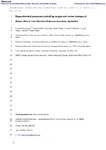Mostrar o rexistro simple do ítem
Biogeochemical Processes Controlling Oxygen and Carbon Isotopes of Diatom Silica in Late Glacial to Holocene Lacustrine Rhythmites
| dc.contributor.author | Hernández, Armand | |
| dc.contributor.author | Bao, Roberto | |
| dc.contributor.author | Giralt, Santiago | |
| dc.contributor.author | Barker, Philip | |
| dc.contributor.author | Leng, Melanie | |
| dc.contributor.author | Sloane, Hilary | |
| dc.contributor.author | Sáez, Alberto | |
| dc.date.accessioned | 2024-03-22T17:34:20Z | |
| dc.date.available | 2024-03-22T17:34:20Z | |
| dc.date.issued | 2010-05-19 | |
| dc.identifier.citation | Armand Hernández, Roberto Bao, Santiago Giralt, Philip A. Barker, Melanie J. Leng, Hilary J. Sloane, Alberto Sáez, Biogeochemical processes controlling oxygen and carbon isotopes of diatom silica in Late Glacial to Holocene lacustrine rhythmites, Palaeogeography, Palaeoclimatology, Palaeoecology, Volume 299, Issues 3–4, 2011, Pages 413-425, ISSN 0031-0182, https://doi.org/10.1016/j.palaeo.2010.11.020. (https://www.sciencedirect.com/science/article/pii/S0031018210006966) | es_ES |
| dc.identifier.issn | 0031-0182 | |
| dc.identifier.uri | http://hdl.handle.net/2183/35967 | |
| dc.description | Preprint version of the article. | es_ES |
| dc.description.abstract | [Abstract] Biogeochemical cycles and sedimentary records in lakes are related to climate controls on hydrology and catchment processes. Changes in the isotopic composition of the diatom frustules (δ18Odiatom and δ13Cdiatom) in lacustrine sediments can be used to reconstruct palaeoclimatic and palaeoenvironmental changes. The Lago Chungará (Andean Altiplano, 18°15′S, 69°10′W, 4520masl) diatomaceous laminated sediments are made up of white and green multiannual rhythmites. White laminae were formed during short-term diatom super-blooms, and are composed almost exclusively of large-sized Cyclostephanos andinus. These diatoms bloom during mixing events when recycled nutrients from the bottom waters are brought to the surface and/or when nutrients are introduced from the catchment during periods of strong runoff. Conversely, the green laminae are thought to have been deposited over several years and are composed of a mixture of diatoms (mainly smaller valves of C. andinus and Discostella stelligera) and organic matter. These green laminae reflect the lake's hydrological recovery from a status favouring the diatom super-blooms (white laminae) towards baseline conditions. δ18Odiatom and δ13Cdiatom from 11,990 to 11,530cal years BP allow us to reconstruct shifts in the precipitation/evaporation ratio and changes in the lake water dissolved carbon concentration, respectively. δ18Odiatom values indicate that white laminae formation occurred mainly during low lake level stages, whereas green laminae formation generally occurred during high lake level stages. The isotope and chronostratigraphical data together suggest that white laminae deposition is caused by extraordinary environmental events. El Niño-Southern Oscillation and changes in solar activity are the most likely climate forcing mechanisms that could trigger such events, favouring hydrological changes at interannual-to-decadal scale. This study demonstrates the potential for laminated lake sediments to document extreme pluriannual events. | es_ES |
| dc.description.sponsorship | The Spanish Ministry of Science and Innovation funded the research at Lago Chungará through the projects ANDESTER (BTE2001-3225), Complementary Action (BTE2001-5257-E), LAVOLTER (CGL2004-00683/BTE), GEOBILA (CGL2007-60932/BTE) and CONSOLIDER-Ingenio 2010 GRACCIE (CSD2007-00067). A. Hernández have benefited from a FPI grant from The Spanish Ministry of Science and Innovation. The Limological Research Center (USA) provided the technology and expertise to retrieve the cores. We are grateful to CONAF (Chile) for the facilities provided in Parque Nacional Lauca. The NIGL (UK) funded the isotope analyses. Chris P. Kendrick is thanked for conducting the carbon isotope measurements. We also wish to thank Juan J. Pueyo for valuable discussions on the manuscript and Alice Chang for her insight on the implications of self-sedimentation processes in the formation of the laminated sediments. | es_ES |
| dc.language.iso | eng | es_ES |
| dc.publisher | Elsevier | es_ES |
| dc.relation | info:eu-repo/grantAgreement/MICYT/Plan Nacional de I+D+i 2000-2003/BTE2001-3225/ES/ | es_ES |
| dc.relation | info:eu-repo/grantAgreement/MICYT/Plan Nacional de I+D+i 2004-2007/CGL2004-00683/ES/FENOMENOS EXTREMOS EN EL REGISTRO SEDIMENTARIO DE LAGOS EN CONTEXTO VOLCANICO-HIDROTERMAL ACTIVO/ | es_ES |
| dc.relation | info:eu-repo/grantAgreement/MEC/Plan Nacional de I+D+i 2004-2007/CGL2007-60932/ES/RECONSTRUCCION PALEOCLIMATICA DE ALTA RESOLUCION DESDE EL ULTIMO MAXIMO GLACIAR BASADA EN INDICADORES GEOQUIMICOS Y BIOLOGICOS DE LAGOS ANDINOS Y DEL OCEANO PACIFICO/ | es_ES |
| dc.relation | info:eu-repo/grantAgreement/MEC/Plan Nacional de I+D+i 2004-2007/CSD2007-00067/ES/MULTIDISCIPLINARY RESEARCH CONSORTIUM ON GRADUAL AND ABRUPT CLIMATE CHANGES, AND THEIR IMPACTS ON THE ENVIRONMENT (GRACCIE)/ | es_ES |
| dc.relation.uri | https://doi.org/10.1016/j.palaeo.2010.11.020 | es_ES |
| dc.subject | Oxygen isotopes | es_ES |
| dc.subject | Carbon isotopes | es_ES |
| dc.subject | Diatoms | es_ES |
| dc.subject | Lacustrine sediments | es_ES |
| dc.subject | Andean Altiplano | es_ES |
| dc.subject | ENSO | es_ES |
| dc.title | Biogeochemical Processes Controlling Oxygen and Carbon Isotopes of Diatom Silica in Late Glacial to Holocene Lacustrine Rhythmites | es_ES |
| dc.type | info:eu-repo/semantics/preprint | es_ES |
| dc.rights.access | info:eu-repo/semantics/openAccess | es_ES |
| UDC.journalTitle | Palaeogeography, Palaeoclimatology, Palaeoecology | es_ES |
| UDC.volume | 299 | es_ES |
| UDC.issue | 3–4 (15 January 2011) | es_ES |
| UDC.startPage | 413 | es_ES |
| UDC.endPage | 425 | es_ES |
| dc.identifier.doi | 10.1016/j.palaeo.2010.11.020 |
Ficheiros no ítem
Este ítem aparece na(s) seguinte(s) colección(s)
-
GI-GRICA - Artigos [49]






